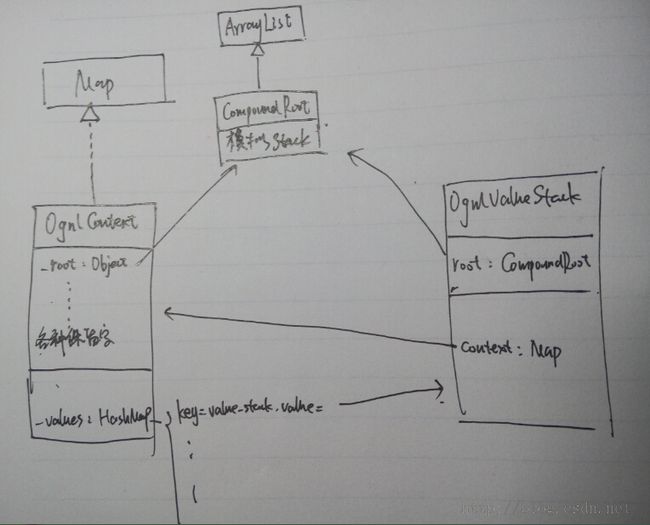OgnlContext、OgnlValueStack、CompoundRoot的数据结构
在上一篇从struts2的action中看ActionContext的存储结构中已经看到ActionContext.getActionContext.getContextMap()得到的map的大体结构类型。
这篇将从源代码层面进行分析。
一、回顾
在上一篇中看到ActionContext中存放的是OgnlContext这个类,这个类的源代码,在OgnlContext源码分析中已经将的比较清楚了。那么值栈ValueStack到底是什么鬼。
二、ValueStack
我们就从ActionContext类中的getValueStack()方法入手:
public ValueStack getValueStack() {
return (ValueStack) get(VALUE_STACK);
}
public Object get(String key) {
return context.get(key);
}
看来要得到这个值栈,还是要从context这个所谓的map中去取。
这个context的实际类型是OgnlContext,还记得OgnlContext是由一系列保留的Object以及一个HashMap共同维护的:先找保留的key,找不到再去HashMap中去找。
这里的key为VALUE_STACK,是要从HashMap中取的(还记得这个HashMap的属性名为_values)
也就是说,ValueStack是藏在OgnlContext中_values属性的hashMap的key为VALUE_STACK对应的值中。
在action中打印一下ValueStack真实的类:
System.out.println(ActionContext.getContext().getValueStack().getClass()); //结果 //class com.opensymphony.xwork2.ognl.OgnlValueStack那么我们就打开OgnlValueStack来看里面的源代码。
三、OgnlValueStack
1.两个重要的属性
CompoundRoot root;
transient Map<String, Object> context;
2.先来说说这个叫做root的属性:
CompoundRoot比较陌生,打开类看一下:
/*
* Copyright 2002-2006,2009 The Apache Software Foundation.
*
* Licensed under the Apache License, Version 2.0 (the "License");
* you may not use this file except in compliance with the License.
* You may obtain a copy of the License at
*
* http://www.apache.org/licenses/LICENSE-2.0
*
* Unless required by applicable law or agreed to in writing, software
* distributed under the License is distributed on an "AS IS" BASIS,
* WITHOUT WARRANTIES OR CONDITIONS OF ANY KIND, either express or implied.
* See the License for the specific language governing permissions and
* limitations under the License.
*/
package com.opensymphony.xwork2.util;
import java.util.ArrayList;
import java.util.List;
/**
* A Stack that is implemented using a List.
*
* @author plightbo
* @version $Revision: 894090 $
*/
public class CompoundRoot extends ArrayList {
public CompoundRoot() {
}
public CompoundRoot(List list) {
super(list);
}
public CompoundRoot cutStack(int index) {
return new CompoundRoot(subList(index, size()));
}
public Object peek() {
return get(0);
}
public Object pop() {
return remove(0);
}
public void push(Object o) {
add(0, o);
}
}
这样看来,不要太简单,就把他当做是一个Stack来看把。
3.再来看看这个context属性:
在OgnlValueStack的构造方法都调用的
protected void setRoot(XWorkConverter xworkConverter, CompoundRootAccessor accessor, CompoundRoot compoundRoot,
boolean allowStaticMethodAccess) {
this.root = compoundRoot;
this.securityMemberAccess = new SecurityMemberAccess(allowStaticMethodAccess);
this.context = Ognl.createDefaultContext(this.root, accessor, new OgnlTypeConverterWrapper(xworkConverter), securityMemberAccess);
context.put(VALUE_STACK, this);
Ognl.setClassResolver(context, accessor);
((OgnlContext) context).setTraceEvaluations(false);
((OgnlContext) context).setKeepLastEvaluation(false);
}
这里又多出一个Ognl工具类,先不用管具体的代码,只要知道Ognl.createDefaultContext他是产生了一个OgnlContext对象,然后返回。
应该还记得,OgnlContext这个类实现了Map接口,Map context=ognlContext是完全没问题。
到这里也要记住,root他放的是一个stack,context放的是一个OgnlContext
四、OgnlContext
再回来看下Ongl这个工具类是怎么初始化一个OgnlContext对象的。
public static Map createDefaultContext( Object root, ClassResolver classResolver, TypeConverter converter, MemberAccess memberAccess )
{
return addDefaultContext( root, classResolver, converter, memberAccess, new OgnlContext() );
}
public static Map addDefaultContext( Object root, ClassResolver classResolver, TypeConverter converter, MemberAccess memberAccess, Map context )
{
OgnlContext result;
if (!(context instanceof OgnlContext)) {
result = new OgnlContext();
result.setValues(context);
} else {
result = (OgnlContext)context;
}
if (classResolver != null) {
result.setClassResolver(classResolver);
}
if (converter != null) {
result.setTypeConverter(converter);
}
if (memberAccess != null) {
result.setMemberAccess(memberAccess);
}
result.setRoot(root);
return result;
}
参数太多不管,只要看到root传过来就行了。
然后在return之前调用了setRoot方法,什么意思呢?
在OgnlContext中的_root属性上放的是一个Stack,就是叫做CompoundRoot的那个东西。
五、总结
可以看到,OgnlContext、OgnlValueStack之间的互相引用有些复杂:
OgnlContext=保留字+HashMap
HashMap=key:value...+value_stack:ognlValueStack
保留字=其他保留字+CompoundRoot
OgnlValueStack=CompoundRoot+OgnlContext
上丑图:
